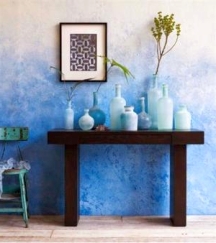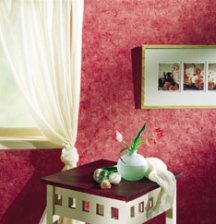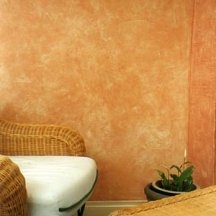Sponge Painting Techniques:
Tips, Ideas and Instructions
Sponge painting is the decorative application or removal of paint glaze onto, or from the walls (or other flat surfaces).
The technique derives its name from the basic tool - a sponge, and its character from the kind of sponge you use - a sea sponge.
Sponging was one of the first decorative painting techniques to gain mass appeal in the 1980s.

And although sponging in high-contrast paint colors and with a heavy-handed technique has since fallen out of favor, this finish is still popular and can look very relevant if you follow the color advice and use updated color combinations as suggested on this website.
In fact, even today, sponging is usually the first faux finish most people attempt in their homes, and no wonder: it's the most versatile decorative paint finish that's quick, easy and inexpensive to create, with materials and tools readily available in any home improvement center or paint store.
Sponge Painting Is
Just a Smart Finish
Paint sponging produces highly textured finishes that offer not only decorative value, but some practical benefits as well.
For example, they can:

- camouflage many flaws and disguise surface imperfections, making them an ideal painting solution for old walls in poor condition, and a cheap alternative to drywall replacement.
- hide dirt in areas prone to getting soiled and stained - kitchens, hallways, mudrooms and children's rooms.
- withstand the use in high-traffic areas because oil glazes are durable, latex glazes can be topcoated with a sealer for extra protection, and the random patterns are easy to touch up inconspicuously if needed.
Sponging Does Not Always
Look Like Sponging
Sponge painting techniques can be done on any flat, painted surface - walls, ceilings, floors and even furniture.
The look can range from delicate to bold, and can be adapted to any
decorating style (the final result will depend on the colors you choose,
the transparency and glossiness of your glaze, and how heavily you
apply it).

For the most common sponging process, sponging on, you use a large sea sponge to dab a glaze onto a painted surface.
See how the irregular shape and surface of a sea sponge has created a lively flecked effect in the photo example?
If you do it right, it should look like irregular mottled texture rather than a series of the same sponge imprints.

For sponging off, a related but quieter technique, you first roll the glaze over a painted surface and then lift off some of the wet glaze with the sponge.
This treatment will produce a subtler, softly
dappled finish where the emphasis is more on the color play than on the
texture.
In addition, these 2 methods can be combined for an even
greater visual depth, or as part of other decorative painting
techniques (for example, faux marble effects).
Ready to Learn Paint Sponging?
Then Let's Get Started!
How to Sponge Paint ON the Walls
Sponging on (also known as the positive, or additive method) can be done using one, two or even 4 glaze colors. Here you will find step by step instructions for the basic and advanced techniques, and modifications for dense and barely-there applications.
How to Sponge Paint OFF the Walls
Sponging off (also called the negative, or subtractive method) is usually done with an oil-based glaze, but can work in water-based mediums in some situations. You will learn several ways to lift the glaze off for different decorative effects, and to combine the additive and subtractive techniques in one application.
Tips and Tricks for Sponge Painting Walls
Even though sponge painting is considered one of the easiest painting techniques to pull off even for beginners, many people still do it wrong. So if you don't want your own project to join the unofficial Hall of Shame, use these professional secrets for a smoother sponging process.
Examples of Sponge Painting Techniques
Different strokes for different folks - you will agree once you see how many effects a simple sponge + glaze can create on the walls to suit any taste! This page will give you several paint sponging ideas and examples to help you find just the right finish for your situation.
HOUSE PAINTING TUTORIALS








